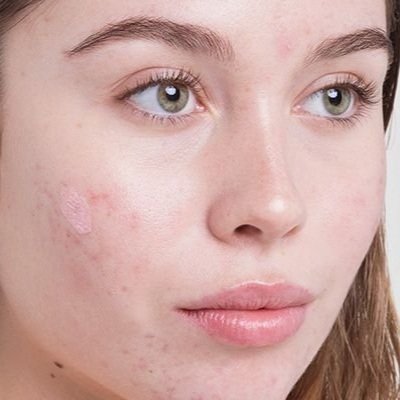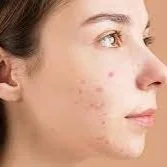Acne Problem? How To Identify, Prevent & Heal Acne
Acne is a worldwide problem that can affect anyone of any age and gender. Even babies can sometimes be born with acne! Although theirs usually clears up on its own.
Sometimes acne is simply annoying and perhaps unsightly. In more severe cases it can be painful and leave scars. In extreme cases, it impacts the quality of life, making the unlucky person’s skin feel painful even when they aren’t touching it and impacting their self-esteem.
Extreme cases like this are likely cystic acne and may require medication to treat. But lesser forms of acne can easily benefit from at-home TLC! Some products might also be helpful for people with severe acne in tandem with medication.
WHAT CAUSES ACNE?
Acne is caused by clogged pores and hair follicles. That’s it! The method of clogging, the location in the skin where the clog causes inflammation, and the different types of substances present in the clog are what cause the different presentations of acne.
But they all started from the same source: blocked pores and hair follicles. The medical term for acne is Acne Vulgaris. As if it wasn’t annoying enough without being called vulgar!
THE 4 TYPES OF ACNE
There are four methods by which someone can experience acne.
Hormonal
Probably the type of acne we are most familiar with and think of most often. Hormonal changes can occur at many different times in a person’s life, but most often we see hormonal acne occur during puberty, at certain times in the menstrual cycle, during menopause, and as a result of PCOS or fluctuating androgen hormones.
Sometimes people can have hormonal imbalances due to environmental factors or an unbalanced diet. Pubescent hormonal acne is more likely to appear in the T-zone, and adult hormonal acne is more likely to appear around the jawline and lower part of the cheeks.
Cystic
Another well-known type of acne, cystic acne is caused when regular blockages to pores become infected with bacteria. This causes inflammation, redness, swelling, and pain. It creates boil-like bumps on the skin that originate from the deeper layers of the dermis. The cysts are filled with pus and are likely to come back and leave scars on the skin.
This is the most severe form of acne. The cysts can burst, leaving an open wound prone to infection. In order to treat the cysts, you may need oral and topical medications, even antibiotics! Contributing factors include stress, highglycemic (sugary) foods, and sweat.
Nodular
Similar to cystic acne in terms of appearance, the main difference between nodular and cystic acne is that nodular acne creates hard lumps that are not filled with pus.
It is caused when a specific type of bacteria enters a clogged pore along with sebum and dead skin. Nodular acne is very likely to scar and does require medical treatment to clear up because it is so far under the skin that once a nodule appears, there isn’t a safe way to treat it at home.
Fungal
Perhaps the least-known form of acne, fungal acne is caused by… fungus! It is NOT a type of acne vulgaris. It occurs when yeast, which is always present on the skin and is part of a healthy skin biome, becomes too abundant and infects hair follicles.
Yeast overgrowth happens when conditions are created that allow the yeast to grow too rapidly. Contributing factors are trapped moisture, certain medications, suppressed immune system, diet changes, wearing tight clothes too much, and warm, moist environments.
Fungal acne can look like acne vulgaris which can cause the person with acne to attempt to treat it with typical remedies like salicylic acid, but that has no effect on yeast. You need to enact a yeast-reducing protocol which can include anti-fungal medications or soaps and bathing more often, ensuring to dry off well each time.
6 SYMPTOMS OF ACNE
There are 6 distinct types of acne presentations. These can form anywhere on the body, not just the face (unfortunately).
Whiteheads
A type of comedo (the plural is “comedones”) where the surface of the skin is closed, leading to the well-known white spot with a small bump on the skin. These form when sebum and skin cells have prevented a clogged hair follicle from opening. Whiteheads are white because, due to the closed skin on top, the melanin and sebum do not become oxidized.
Blackheads
A type of comedo where the surface of the skin remains open, causing the tiny black dot appearance. They form when sebum and skin cells clog a pore. The black colour is from the oxidation of the sebum and melanin located in the clogging substance.
Papules
When comedones become inflamed, they form papules. Characterised by small red or pink bumps on the skin, perhaps with a white spot in the middle, they may be sensitive or painful to touch. Though these look like there should be a lot of gunk to extract from inside, they usually do not yield very much and can cause even more acne or scarring if you do pop them.
Pustules
Similar to papules, pustules are red bumps with a white or yellow spot in the middle. Unlike papules, pustules will likely pop if you squeeze them. However, they will likely cause more acne and scarring if you pop them.
Nodules
Formed deep within the skin, nodules are likely sensitive to touch and might be painful even when not being touched. They feel firm and will likely not be able to be popped if you tried. Of course, popping them could lead to scarring. Nodules usually require medication to eradicate. They are caused by Cutibacterium acnes bacteria that have made its way into the skin.
Cysts
Cysts are softer than nodules because they are pus-filled, unlike nodules. They also form deep under the skin. They are also likely to be painful and inflamed. Cysts are formed when a milder form of acne like a papule becomes infected with Propionibacterium acnes bacteria. The middle layer of skin becomes inflamed and that’s where the cyst forms.
PREVENT ACNE BREAKOUTS
The best way to treat acne is to prevent it from happening in the first place. While acne cannot always be completely avoided, there are many ways you can reduce the chances that it will pop up.
Wash Your Face At Night
Washing your face in the morning can be really refreshing! But it’s really important to wash off all the makeup, sweat, dirt, and excess oil before you go to sleep. Otherwise, it can sit on the skin all night long and accumulate on your pillowcase, causing the fabric to be overgrown with the bacteria and yeast that are always on the skin. Rubbing your face on all of that all night, every night does not bode well for staying acne-free.
If your face gets too dry from a twice-a-day wash, try simply using water in the morning and cleanser at night.
Wash Your Face After Exercising
Likewise, when you get excess moisture on your face, you need to wash that off sooner rather than later. You might also need to take a shower if you tend to get body acne. Leaving the sweat on for too long can cause clogged pores and bacterial and yeast overgrowth. Stop pimples from appearing on the face with a refreshing wash after sweaty or dusty activities.
Avoid Face-Touching and Have Clean Hands
Avoid touching the face as much as possible at all times. There is oil present on the fingers that can transfer to the face causing blockages. If you do need to touch your face, like when applying products or scratching an itch, make sure your hands are freshly washed. This ensures there is less excess oil and no foreign bacteria present that can jump into a follicle and cause a pustule.
Use Skin-Safe Products
Some skincare products are simply not good for most people’s skin. Make sure you always use non-comedogenic products which won’t block pores. You also want to be sure to use products that agree with your skin type (oily, dry, sensitive, normal).
Preventative Care
Build a skincare routine that helps your unique skin environment stay healthy and clear. Use cleansers appropriate for your skin type(s) (because you can have more than one on your whole body), exfoliate once or twice per week to slough off dead skin and dirt, and moisturise to keep your skin’s biome nourished.
PREVENT ACNE SCARS
In the case where you do find yourself with acne anywhere on your body, it’s important to NOT pop them! I know, I know. It’s tempting and at times, very satisfying.
There are very few times when popping any type of acne is advisable. Doing so can create a large or ragged hole in the skin, leaving you open to more severe infection and scarring.
Prevent acne scars by diligently taking care of your skin with acne-fighting ingredients. Don’t over-scrub with exfoliants, as that can irritate the skin and cause tears for bacteria to enter and cause even more acne spots.
If you have cystic or nodular acne, you should see a dermatologist or doctor to help get the nodules and cysts cleared up ASAP. Even if you take the very best care of your skin on your own, these types of acne are simply too severe to be left to heal. Typically, they will take so long to heal, they’ll recur, and they may become too infected to treat at home. They tend to scar and leave hyperpigmentation very easily.
If you have fungal acne, make sure you treat for fungus, not bacteria or overproduction of sebum. Sometimes you might need to get a swab test to confirm fungal acne. You can feasibly treat fungal acne on your own with certain ingredients and care, but in some cases, you may require a prescription.
If you have acne on your face or body, you can do a lot to prevent and heal it at home. Severe forms of acne are more troublesome, but don’t lose hope! Clean, clear skin is possible!







